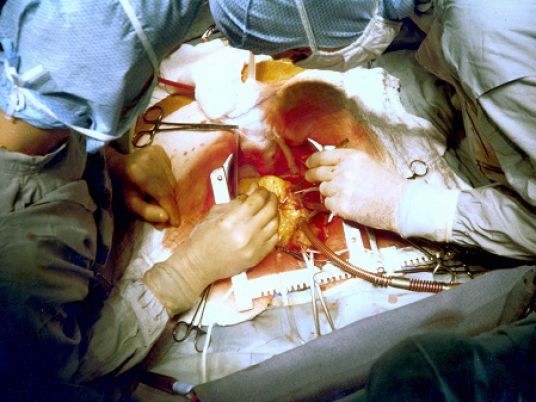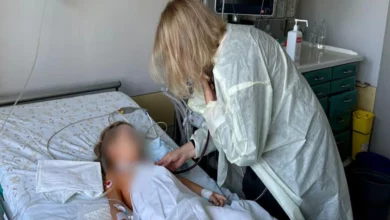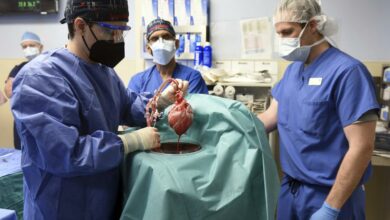
While waiting for a human heart transplant, Stan Larkin lived 555 days without the organ at all.
To passers-by, the 25-year-old Ypsilanti, Michigan, resident appeared to be a typical young adult. He enjoyed taking his three toddlers to the park and hanging out with his younger brother, Dominique.
What wasn't obvious was that a gray backpack Larkin carried was what kept him alive. Inside that bag was the power source for an artificial heart pumping in his chest.
Larkin's real heart was removed from his body in November 2014. It was replaced with a device that allowed Larkin to stay home instead of in a hospital while waiting to receive a transplant.
It finally arrived this year, in May. Now, Larkin is recovering from his procedure at the University of Michigan Frankel Cardiovascular Center. He is scheduled to return home as early as next week.
"Most people would be scared to go so long with [an artificial heart], but I just want to tell them that you have to go through the fear, because it helps you," Larkin said. "I'm going home so fast after the transplant because it helped me stay healthy before the transplant."
At any given time, there are about 4,000 patients nationwide waiting for human heart transplants, according to the US Organ Procurement and Transplantation Network.
Some patients with end-stage heart failure may wait months or even years before a suitable donor heart becomes available, said Dr. Billy Cohn, a cardiovascular surgeon and director of the Center for Technology and Innovation at the Texas Heart Institute.
"Many of these patients have hearts that are so weak, the kidneys, liver and other critical organs will fail while they are waiting," said Cohn, who was not involved in Larkin's care. "Many of these patients would die without some form of support," such as an artificial heart.
'A machine was going to be my heart'
Larkin didn't realize that his heart was suffering until nine years ago, when he collapsed without warning while playing in a basketball game. It turned out that Larkin had a genetic form of heart disease called familial cardiomyopathy. His brother, Dominique, 24, was soon found to have it, too.
The condition occurs when heart muscle stretches and enlarges the open area of at least one heart chamber, inhibiting the organ from pumping blood efficiently.
The type of cardiomyopathy seen in Stan and Dominique, called arrhythmogenic dysplasia, causes arrhythmias and failure on both sides of the heart, said Dr. Jonathan Haft, a cardiac surgeon at the University of Michigan who operated on the brothers.
"It's an awful condition to have," Haft said. "But the technology available and the technology that is evolving in the field of heart failure is very exciting… The total artificial heart falls into that category."
Both brothers eventually progressed to heart failure and cardiogenic shock, and they were equipped with artificial heart devices in late 2014. Dominique stayed in the hospital with his device for six weeks before receiving a human heart transplant.
But Larkin, who was thriving with the device, was the perfect candidate to live outside the hospital, Haft said.
"I was shocked when the doctors started telling me that I could live without a heart in my body and that a machine was going to be my heart. Just think about it — a machine," Larkin said.
'It feels like a real heart'
It's not the first time a patient has lived for a long time with an artificial heart, but Larkin became the first patient in Michigan to go home with the portable device.
The SynCardia temporary artificial heart in Larkin's chest replaced his failing heart, including its chambers and four valves. Two tubes, exiting the left side of Stan's body beneath the ribcage, connected the artificial heart to a 13-pound machine called the Freedom Driver.
The driver, which was carried in a backpack, not only powered the artificial heart, it delivered pumps of compressed air into the heart's ventricles, allowing blood to be pumped through the body.
"Stan was very active and did an immaculate job taking care of himself and taking care of the equipment used to keep him alive," Haft said.
With his life-saving backpack in tow, Larkin played pick-up games of basketball, enjoyed time with his children and rode in the car with his friends.
"It's just like a real heart," Larkin said. "It's just in a bag with tubes coming out of you, but other than that, it feels like a real heart. … It felt just like a backpack with books in it, like if you were going to school."
Voncile McCrae, Larkin's mother, often helped him change the bandages covering the holes in his body where the tubes emerged.
"We had to be careful so that he wouldn't get an infection," McCrae said, chuckling about how she had been scared to touch the tubes and handle the Freedom Driver machine. "Now, I'm a pro."
'An amazing brother'
The technology that, temporarily, was a part of Larkin's body shows just how advanced artificial heart devices have become since the world's first self-contained artificial heart was implanted in a patient in 2001, said Dr. Laman Gray, Jewish Hospital chair in cardiovascular surgery at the University of Louisville.
Gray was one of the celebrated surgeons who performed that first artificial heart procedure. He has closely followed developments in the fields of cardiac surgery, such as Larkin's case.
"I think there's good science here, and there have been really great advancements in this area," Gray said. "We're making great progress, and people are living normal lives. There's definitely a place for total artificial hearts and a need for them."
Dominique said he and his brother are grateful that their needs were met — and that they survived.
"I have an amazing brother," Dominique said. "He has been here with me since the beginning and has never let me down. … I'm blessed to have him in my life."


